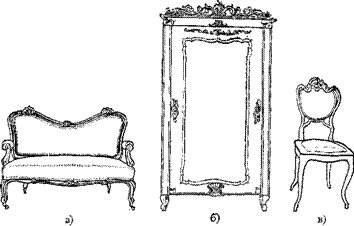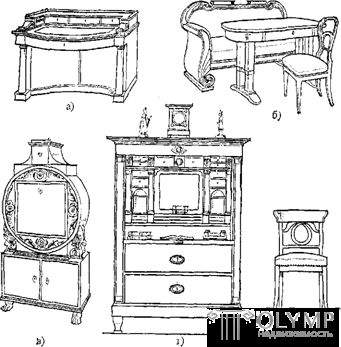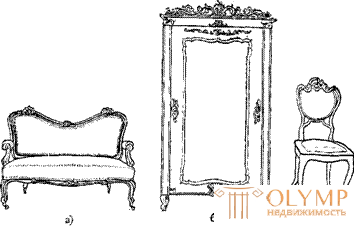
European furniture (1810–1848) is characterized by a new style, which later received the conditional name “Biedermeier” (Biedermeier, German - the gallant Mr. Meyer) - synonymous with philistinism (introduced by the poet Eichrodt). Biedermeier was the style of modest bourgeois dwellings. By construction and laconicism, it is close to the Empire style, but is devoid of its coldness and aristocracy. The development of the Biedermeier style was greatly influenced by the bourgeois furniture of England of the late 18th — early 19th centuries.
Biedermeier style was especially common in Germany and Austria. Biedermeier style furniture is practical and comfortable. There was a combination of furniture: sliding tables, tables with retractable and hinged lids (Fig. 1, a), sofas with gently curved backs and armrests (Fig. 1.6). Cabinet furniture is various (fig. 1, c, d): buffets, secretaries. For the Biedermeier style, a single-door wardrobe is typical.
The legs and backs of chairs and armchairs are provided with a slight bend, the backs are mostly openwork, the seats are soft or wicker (Fig. 1, e). Beds with simple smooth surfaces of the head and foot shields, the same height.

Fig. 1. Biedermeier style furniture: a - combined writing stop, b - headsets, c, d - secretaries, d - chair
Tables are varied in form and purpose. Round tables with a polygonal cross-section of veneered support mounted on a wide solid board dominate. Make tables and with three or four legs. Legs, sideboards and tabletops are devoid of decor. For the installation of indoor plants in flower baskets and vases used various coasters.
In Biedermeier style furniture, veneering was widely used, covering the doors and front surfaces of furniture products, and sometimes the legs and armrests of armchairs, chairs and sofas with hand-planed 2–4 mm thick plywood sheets. Used mainly light wood species: sweet cherry, pear, maple, poplar, ash. Upholstered upholstered furniture with chintz and reps, which are often nailed with large white porcelain hats.

Fig. 2. Neorococo furniture: a - sofa, b - wardrobe, c - chair
Already in the 20s of the XIX century. Biedermeier-style furniture becomes more diverse and richer: curved legs appear, complex outlines, rococo shapes return. On this basis, a new trend in art and, in particular, in furniture, neorococo, emerged.
Neorococo (1830-1860) originated in France and received the name of the style of Louis-Philippe.
Neocaocco was very popular in Austria. The furniture of Viennese craftsmen was especially valued, including the work of Johann Dungauser.
Closest in form to the Rococo style furniture for seating (Fig. 2, a, c). In the furniture style neorokoko were distributed small-sized furniture products. Single-door wardrobes (Fig. 2, b) remain straightforward in solving the basic volume and are decorated with a rococo decor. Neorokoko reflected the desire of the richest bourgeoisie for luxury and pomp. In neorococco style, eclecticism first manifests itself, that is, a mechanical combination of forms of past styles.
The second half of the XIX century. characterized by a passion for styles of the past, resulting in the emergence of the so-called pseudo, or new styles. In the XIX century. It has not yet created a style form corresponding to the peculiarities of the economic, social and spiritual life of the bourgeoisie. In the period of the spread of factory production, craft is separated from art, and at first a genuine artistic beginning is completely absent in industrial products.
If previously all the subject environment of a person was created by individual artists and artisans, then from the end of the 18th century. machine production invades this area. Originally, the furniture made by machine was rather rough and imperfect, but it was much cheaper and began to crowd out more expensive products by artists and craftsmen and artisans on the market. The artistic qualities of the furniture are falling. In order to give machinery the visibility of traditional works of applied art, they began to use forms of styles from past historical eras. The viciousness of eclecticism in its design character, the distortion of the essence of the design, the technical form, the contradiction of the form of the product to its purpose.
Что бы оставить комментарий войдите
Комментарии (0)